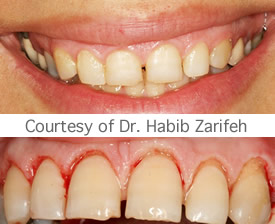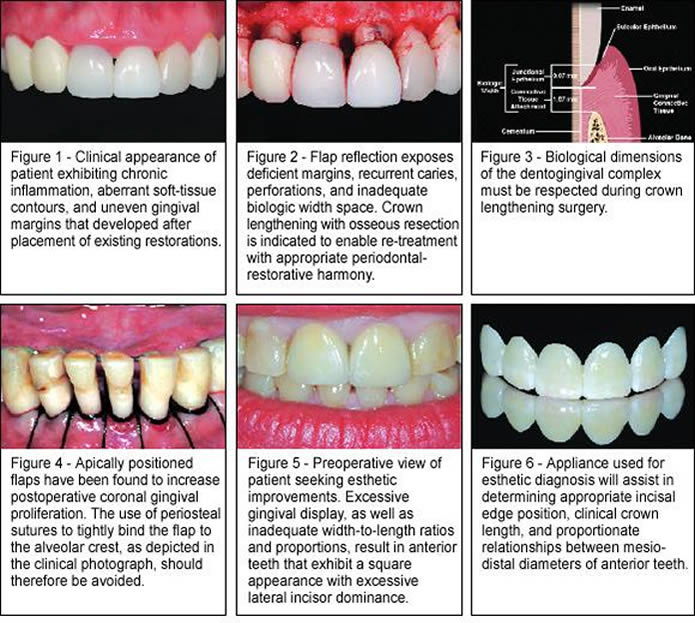Gummy Smile
A gummy smile is a condition in which gingival tissue is located more on the cervical third of the crowns than is normal, resulting in teeth that appear shorter and "gummy."
The etiologies of a gummy smile:
There are several possible causes of gummy smile, including:
- An excessive display of gum tissue in your upper jaw can result from the abnormal eruption of the teeth. Teeth covered by excessive gum tissue appear short, even though they may actually be the proper length.
- The muscle that controls the movement of your upper lip could be hyperactive, causing your upper lip to rise up higher than normal. When this occurs, more of your gum tissue is exposed when you smile.
- The manner in which your upper jaw bone grew and developed could cause the appearance of a gummy smile. For instance, if there was an excessive bulging protrusion of the upper jaw within the gum tissue, you would experience an obvious gummy appearance when you smile.
Watch video:
gummy smile laser treatment by Ferrari Dental Clinic Beirut Lebanon
http://www.youtube.com/watch?v=BGbe9CiQGwQ
gummy smile laser treatment Beirut Lebanon by Ferrari Dental Clinic.m4v
http://www.youtube.com/watch?v=aLF6Mywz6kc

Gummy Smile: An Esthetic Problem or Something More?
The smile line or aesthetic zone – the teeth that are showing when you are smiling – is determined by several factors, including:
- The shape and size of your lips.
- Your facial muscles.
- The shape and size of your teeth.
- Your gum tissue.
The optimal smile line appearance should reveal the least amount of gum tissue possible. Gum tissue visible in the smile line should have balanced, even contours that are in harmony with the upper lip. It is for this reason that many people with a gummy smile or excessive gingival display feel their smile to be unattractive, oftentimes feeling reluctant to smile at all.
However, depending on the factors causing a gummy smile, more serious underlying dental conditions could be present. For example, if you have a gummy smile caused as a result of how the teeth erupted and how the jaw developed, you may also have an uncomfortable or improper bite that could ultimately affect your long-term oral health.
Orthodontic treatment, Laser Gummy smile surgery and lumineers placement on the 2 lateral upper incisors


Ferrari Dental Clinics Gummy Smile Treatment options:
Depending on the nature of your specific clinical condition, treatment for your gummy smile could include one or more of the following:
Same-day laser treatments:
There are numerous benefits of using lasers in surgery. The main advantage of this option is that you will have an immediate result.
The procedure is painless, requires no sutures, and the gum tissues usually heal within a few days. Lasers seal lymphatics and reduce the need for post-surgical dressings while shrinking capillaries and improving hemostasis. They also depolarize the nerves, thus reducing postoperative pain, and destroy many bacteria and viral colonies that can cause potential infection.
Other benefits derived from the use of lasers include improved efficiency and expanded capabilities. As the treatment is less painful overall, patient comfort is increased without the need for prescription drugs, and the needs for local anesthesia and postoperative follow-up are diminished.
 Laser Gummy Smile surgery
Laser Gummy Smile surgery
case 1: This 40 Year old patient complained about her teeth being too short and too gummy. She was also troubled by the gap between her central incisors right in the front where everyone can see. The procedure involved removing gum and shaping the bone in order to conserve the biological width. The patient also needed improvement in the shape of her teeth so we placed porcelain veneers to complete her smile. The gummy smile surgery was performed using the waterlase MD with virtually no bleeding at the site. The patient was immediately chilled with her new smile!
Laser surgery lip repositioning:
Sometimes connective tissues attached to the inside of the upper lip do not allow for proper lip movement and expose too much gum tissue above the top row of teeth. By removing specific tissues from inside the upper lip the dentist can lower the upper lip and create a more aesthetic smile. During the laser surgery, the dentist will remove tissue uniformly to avoid any damage to the patient's muscular movements, such as uneven facial expressions. All of the connective tissues controlling the lip's movement will be shortened significantly, showcasing the teeth instead of excessive gums.
Orthodontics (braces):
The orthodontist is going to literally drive your teeth upwards (intrusion of your anterior teeth), then the bone will undergo resorption & gum is going to follow the bone. As a result, normal remodeling to the structures around the teeth will occur. In some cases, in order to prevent unwanted tooth movements the orthodontist will use what is called micro-screw implants to do that He is going to put these tiny screws (2 screws) above the anterior upper teeth. This treatment option will take longer than others.
Le fort I osteotomy (orthognathic surgery):
The goal of this Surgery is to decrease the height of your upper jaw. The Surgeon is going to remove few millimeters of your upper jaw & then He is going to immobilize the bone with mini-plates. You need to do an orthodontic treatment (braces) along with this surgery. So, You are going to be treated by tow specialists, a surgeon & an orthodontist. This option gives great result if you show large amount of Gum. This operation has the most successful & stable results of all the orthognathic surgeries. Nevertheless, it has the usual hazards & complication of any major operation.
the golden rule: the respect of the maintenance of the biological width.
CONVENTIONNAL periodontal procedures for gummy smile treatment:
WHAT OTHERS DO...
Conventionally, Correcting a gummy smile can be accomplished by one of two possible simple surgical procedures.
The first procedure is called a Gingivectomy. Gingivectomies are performed when the amount of gum reduction necessary is minimal such as in mild gummy smiles. Your doctor can increase the length of your teeth by cutting a few millmeters of the gum around the teeth with the scalpel.
More advanced gummy smiles require more extensive tissue reduction. This is performed by a procedure known as crown lengthening. During this painless procedure, the gum tissues are contoured around each individual tooth. The tissue is lifted off the bone and placed in a desired new position. The tissues are sutured into place and allowed to heal for 7 - 10 days. After initial healing, the sutures are removed. The newly repositioned gums are allowed to heal for an additional 2- 3 months before any final restorations can be placed.

